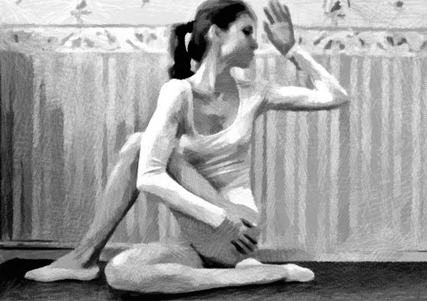|
Take a moment to sit on the ground with your legs extended. Slowly reach forward to touch your toes by flexing your spine and lowering your head to your knees. In this position, you should feel a stretch along the back of your legs. Tight hamstrings right? Not so fast. This tightness could be your nerves being stretched to their limit. This prevents your muscles from stretching any further before damage sets in. The nervous system consists of an interconnected highway that originates in the brain. Healthy nerves require regular movement to stay lubricated and mobile. When nerves become trapped or compressed, especially for prolonged periods, they become immobile, tight, and more likely to become injured. During periods of immobility, the brain sends pins and needles to the neglected neural area. This signal lets you know that one of its’ nerves is agitated. This response is commonly seen when your foot falls asleep after sitting in one position for a period of time. Fortunately, your brain sends these signals before any real danger exists. What Happens When You Stretch? Stretching places tension on more than the muscles. For example, when stretching your hamstring muscles, you are also placing tension on the hip joint, the sciatic nerve, and other posterior ligaments. While you may be stretching the hamstrings, if the nervous system is over-active, you may be exciting a defensive muscle spasm from your brain. Similar to when your leg falls asleep, the nerves send a protective signal against aggressive stretching. Trying to push past this neural response may damage your nerves and cause increased pain and soreness afterward. It is important to realize that the sensation of tightness does not mean that the muscles are short, but a nerve, joint, or soft tissue may be the issue. So Should You Stop Stretching? No way! If you enjoy stretching or yoga, we absolutely recommend it. However, a proper (nerve mobility) warm up will go a long way in lubricating the nerves before more dynamic stretches. Sliding exercises warm-up the nervous system which minimizes the potential for a a localized inflammatory response. Similar to flossing your teeth, sliding exercises allows for excursion of a nerve. They are great for loosening the nerve and are less aggressive than stretching. Check out the video to learn how to lubricate your nervous system prior to more aggressive stretching. The Perfect Nerve Warm-up When it comes to stretching, you cannot follow the no pain, no gain mentality. Start with slow, gentle movements and prime the nervous system before aggressive stretching. Motion is lotion for your nerves. They require movement to stay healthy and receive adequate blood flow and nutrients. In the words Todd Hargrove, “If you mobilize a nerve (without injuring it) it will increase circulation and get healthier because the movement may help squeeze out local inflammation. If you move a nerve pain free, it will be easier to do in the future.” If you consistently feel 'tight' despite regular stretching, contact Heafner Health to see if your nervous system is over-active!References:
Hargrove, Todd. "BETTER MOVEMENT." Nerve Mechanics Part II. Better Movement, 2 Feb. 2009. Web. 25 June 2014.
4 Comments
Manuel Franco
8/29/2023 10:50:13 pm
I just want to say Thank You to everyone who supported me through the years. My name is Manuel Franco, New Berlin, Wisconsin. My story of how I won the Powerball lottery of $768.4M is a bit of a tale. I have been playing Powerball tickets for 6 years now since I turned 18. I bought my first ticket on my 18 birthday. I was feeling very lucky that day because I had contacted Dr. Odunga Michael to help me with the winning Powerball numbers. I really had that great great feeling that I looked at the camera wanting to wink at it. I only did a tiny part of it and trusted him. He gave me the numbers after I played a couple other tickets along with it for $10. I checked my ticket after the winnings came online and saw the numbers were correct including the Power play. I screamed for about 10 minutes because it felt like a dream. I had won $768.4M. You can check my winning testimony with the lottery officials just with my name search. Thank you Dr Odunga. Well, his email is [email protected] and you can also call or Whats-app him at +2348167159012 so you guys can contact him
Reply
Robal
10/2/2023 01:37:09 am
Tired of struggling with stubborn fat? This weight loss product is the solution you've been looking for. From 85kg to a lean 60kg, it's a true game-changer. <a href="https://5afee7o0hq0ijme7-jtdj90v3g.hop.clickbank.net" target="_blank">click here</a> to take charge of your weight!
Reply
Hailey Garcia
6/20/2024 11:07:18 pm
My name is Hailey Garcia and I am from New Jersey. My herpes virus turned to war after 2 years of living with it. I have tried different medical procedures to cure my herpes but to no avail. Most people think herpes is only a minor skin irritation of which herpes has long term effects on health and passes through the bloodstream and can be easily contracted through sexual intercourse. I knew I had herpes from the first day I started feeling itchy in my pubic area and the pain was very unbearable. I couldn't stand it anymore. After 2 years of trying other means to get rid of it, I had to contact Doctor Odunga to help me with a permanent cure. I saw his email and whats-app number from a testimony I read online from a lady who was also helped by him in curing infertility problems, I had faith and contacted him. He assured me of his work and I ordered his herbal medicine. Within 5 days, I didn't feel any pain anymore and within 2 weeks, my skin was all cleared and smooth. I am very grateful to you sir and I write this testimony as others have done to bring those having faith to you sir. If you have herpes or other similar disease and you want it cured, kindly contact Doctor Odunga, Whats-App (wa.me/+2348167159012) OR Email [email protected]
Reply
Leave a Reply. |
Heafner HealthPhysical Therapy Archives
April 2024
Categories |



 RSS Feed
RSS Feed
